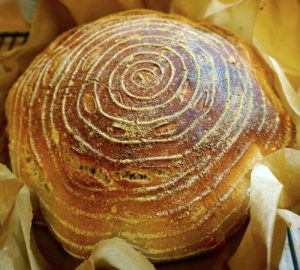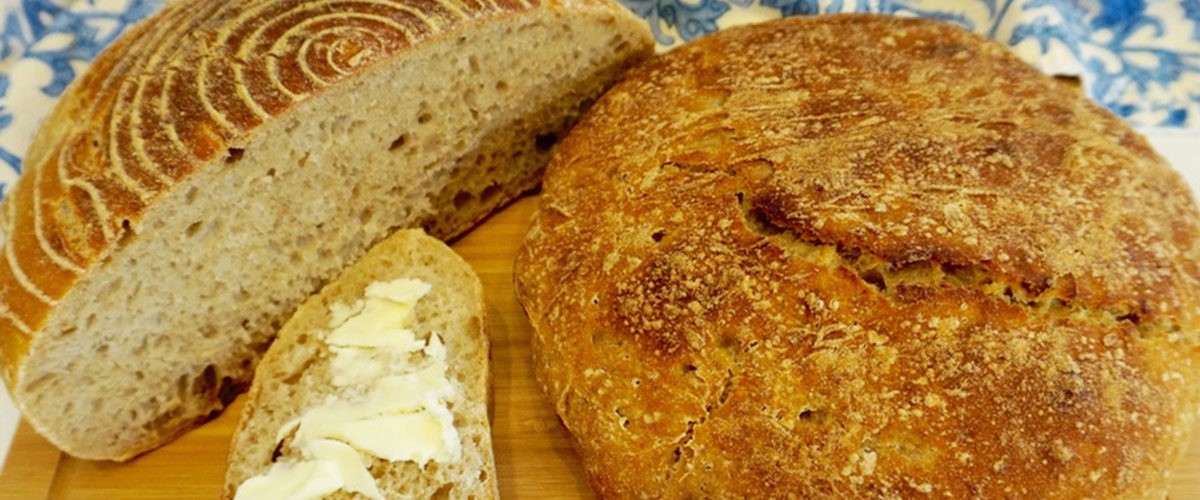By its sacred nature, bread is rich in symbolism. “I am the bread of life,” Jesus said.
Made from the earth’s ingredients, this food represents bodily nourishment, hospitality and a spiritual relationship. “Breaking bread” originated when Jesus would break loaves and pass out pieces to be shared among his disciples, an act of love and generosity. For generations, bread’s life-giving properties and spiritual renewal have drawn us together.

Phawnda Moore
In 2020, baking bread, sourdough bread, became the lockdown obsession. Faced with intermittent shortages of commercial bread as well as flour and yeast, the decision to make one’s own bread established a sense of self-sufficiency and provided a bit of structure to the day. It’s an experience that rewards our senses of touch, smell and taste. When your home is filled with the heavenly aroma of baking bread, there’s hope; something good is in the air.
There are other advantages, too. This activity calms both men and women who feel fearful after reading daily headlines. You can make it your way. And it has health benefits. So for all the above reasons, I joined others on a journey of learning, experimenting, kneading, baking, feasting and sharing its many blessings.
Sourdough, discovered about 3700 BCE in Switzerland, has an interesting history:
- In California, it nourished more than 300,000 fortune seekers in the 1849 California Gold Rush. That year the Boudin Bakery in San Francisco was founded by Isidore Boudin, son of master bakers from France. Many local bakers, including Boudin, claimed the Bay Area’s foggy climate cultivated a specific type of yeast that was unique in a 50-mile radius of their city. In time this claim was disproved, but by then, word of the famous sourdough was known around the world. The bakery still uses a mother starter from that era.
- Travelers often head to Fisherman’s Wharf in San Francisco to enjoy steaming clam chowder in carved-out loaves of sourdough bread; the ocean views and salty air complete this delightful, culinary experience.
- In Alaska, the sourdough tradition was carried on during the Klondike Gold Rush. Today, Talkeetna Roadhouse’s gigantic sourdough pancakes are popular with both tourists and locals. Climbers often stop by for a hearty meal before starting their summit attempts at Denali. And the Unalakleet community welcomes high-energy Iditarod mushers, passing through with their teams of dogs, to sourdough pancakes made from a starter that’s three generations old.
Any way you look at it, sourdough is an adventure to behold. A beginner probably will become familiar with at least 30 new words; purchase kitchen scales, tools, jars, covers, various flours, thermometers and cookbooks just to make a starter. And that critical first step, I learned, can take weeks.
“For generations, bread’s life-giving properties and spiritual renewal have drawn us together.”
After a few days into making the starter, I realized the importance of attitude: show up, observe and assess what is, and often resign to trusting the process. And repeat. “Stay on the path,” I tell myself. “It will work out.”
On Day 7, with two recipes in progress (a rye and a white AP flour), both with minimal to dismal progress, I sighed, closed my eyes and imagined that the rewards were just around the corner. I continued to adjust temperatures with patience and grace and looked longingly at beautiful bread photos.
 When I joined an online baker’s community of 44,000 bakers, novice to pro around the world, I personally experienced bread’s amazing, universal language. Members troubleshoot common issues with each other and experiment in highly creative ways — even testing music’s effect on starters — and share the results. The willingness to embrace the mystery and explore it together with flexibility, innovation and artistic expression, unites the group’s diversity.
When I joined an online baker’s community of 44,000 bakers, novice to pro around the world, I personally experienced bread’s amazing, universal language. Members troubleshoot common issues with each other and experiment in highly creative ways — even testing music’s effect on starters — and share the results. The willingness to embrace the mystery and explore it together with flexibility, innovation and artistic expression, unites the group’s diversity.
Once “proven,” starters are often named. After all, they’re alive, need to be fed, and want to be useful. When I finally knew success, with rye flour, I understood why it was fitting and bestowed the name “Ryan.”
Wherever you are with sourdough, come along to meet “Vitus” as he journeyed from Belgium to a tiny town in Maine.
“Give us this day our daily bread.”
Phawnda Moore is a Northern California artist and author of Lettering from A to Z. In living a creative life, she shares spiritual insights from traveling, gardening and cooking. Find her on Facebook at Calligraphy & Design by Phawnda and Instagram as phawnda.moore


